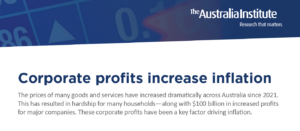The debate about inflation, interest rates, and the cost of living is broken.

Spreading fear about inflation not falling fast enough distorts the true picture
Looking at the latest media reports you would be forgiven for thinking that inflation had started to rapidly increase. While the talk at the beginning of the year was about inflation slowing and possible interest rate cuts later this year, now some of the financial talking heads are suggesting that interest rates need to rise, and Australia might even need a recession to get inflation under control.
How confused you would be then if you happened to stumble onto the Australian Bureau of Statistics website and see that annual inflation rate in the most recent quarter was down half a percent to 3.6%. Annual inflation has almost halved over the last year.
The sudden calls for higher interest rates as the inflation rate continued to fall was so jarring, even the unusually mild-mannered Treasurer, Jim Chalmers, called it an “overreaction”.
Some in the financial commentariat responded that the inflation rate wasn’t falling fast enough. That inflation was sticky and was at risk of stalling outside the RBA’s target range of 2% to 3%. Failing to get inflation back to the target range as quickly as possible, they claimed, was imposing huge costs on the economy and crippling household’s budgets through cost-of-living pressures.
The only problem with all of these claims is that they are misleading nonsense.
The rate of inflation is still falling. The rate at which it is dropping has slowed but that is to be expected. The rate of inflation is not going to crash down at great speed only to suddenly flatten out when it reaches the target band.
It is also important to point out that there is nothing special or magical about the RBA target. The 2% and 3% range is an entirely arbitrary and different countries have different targets. The only real benefit of inflation targets is they target stable inflation. It is not the rate of inflation that causes problems but rather when inflation fluctuating widely.
There is virtually no difference between the current inflation rate of 3.6% and a rate of 3%. Particularly as people are claiming that inflation is sticky. Sticky inflation means it is not rapidly changing.
But what about inflation being the cause of households cost-of-living pain? This too is misleading as it only tells half the story. For households to be losing out inflation needs to be rising faster than their wages.
Which of these two scenarios is going to hurt households more?
Scenario 1: Wage rises of 1% and an inflation rate of 2%.
Scenario 2: Wage rises of 5% and an inflation rate of 4%.
If your wages are growing at 1% but the price of stuff you buy is increasing at 2%, you’re going backwards. But in scenario 2 wages are rising faster than prices. Households are getting ahead despite that fact that inflation is much higher than scenario 1.
Inflation is not causing the cost-of-living crisis. Inflation being higher than wages is what is hurting household budgets. Solving the crisis is as much about lifting wages as it is about decreasing prices.
Strangely many of those calling for higher interest rates and a possible recession are also calling for wage restraint. If they got their way, then the falling rate of inflation might be completely offset by falling wages. Also, a large part of the pain households feel is because interest rates rapidly increased. Calls for even higher interest rates is just going to add to that pain.
The argument put against higher wages is that they are a cost to business. If businesses costs go up then they will lift their prices to cover their increasing costs and this will cause even more inflation. This is an acknowledgment that businesses have all the power in the world to increase prices. Something they have been happy to do during this spike in inflation.
Australia Institute research has shown that businesses have been benefited from this increase in inflation by increasing prices by more than the increase in their costs. The result has been even higher inflation and bigger profits.
While the costs of having a stable inflation rate that begins with a three is virtually zero, we also know that recessions come at a huge cost. Recessions cause rapid rises in unemployment. Large numbers of people are plunged into poverty. Recessions are linked to depression, crime, substance abuse, and relationship breakdowns. They are bringers of mass misery.
If that was not bad enough, they leave economic and social scaring that lasts for years afterwards.
Be suspicious of anyone who says a recession is the solution to the problem and be especially cautious of anyone who talks about a short, controlled recession. History has shown that having crashed a recession into the economy, policy makers quickly lose control and struggle to contain the damage.
Australia needs an honest debate about inflation and the causes of the financial pain many households are currently feeling. Anybody seriously contemplating higher interest rates and a recession should explain the costs and benefits of such an extreme solution.
Between the Lines Newsletter
The biggest stories and the best analysis from the team at the Australia Institute, delivered to your inbox every fortnight.
You might also like
Would you like a recession with that? New Zealand shows the danger of high interest rates
New Zealand’s central bank raised interest rates more than Australia and went into a recession – twice.
Corporate profits increase inflation | Fact Sheet
The prices of many goods and services have increased dramatically across Australia since 2021. This has resulted in hardship for many households—along with $100 billion in increased profits for major companies. These corporate profits have been a key factor driving inflation.
Corporate profits increase inflation
The prices of many goods and services have increased dramatically across Australia since 2021. This has resulted in hardship for many households—along with $100 billion in increased profits for major companies. These corporate profits have been a key factor driving inflation.



